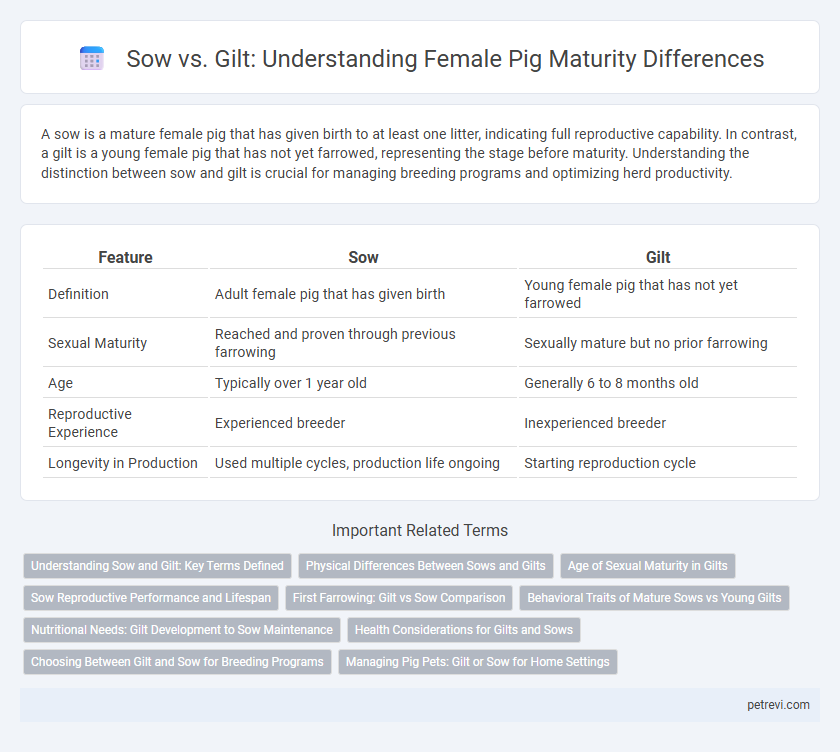A sow is a mature female pig that has given birth to at least one litter, indicating full reproductive capability. In contrast, a gilt is a young female pig that has not yet farrowed, representing the stage before maturity. Understanding the distinction between sow and gilt is crucial for managing breeding programs and optimizing herd productivity.
Table of Comparison
| Feature | Sow | Gilt |
|---|---|---|
| Definition | Adult female pig that has given birth | Young female pig that has not yet farrowed |
| Sexual Maturity | Reached and proven through previous farrowing | Sexually mature but no prior farrowing |
| Age | Typically over 1 year old | Generally 6 to 8 months old |
| Reproductive Experience | Experienced breeder | Inexperienced breeder |
| Longevity in Production | Used multiple cycles, production life ongoing | Starting reproduction cycle |
Understanding Sow and Gilt: Key Terms Defined
A gilt is a young female pig that has not yet given birth, typically under one year of age and showing signs of puberty. A sow refers to a mature female pig that has farrowed at least once, indicating reproductive maturity and proven fertility. Understanding these definitions is crucial for effective breeding management and optimizing pig production cycles.
Physical Differences Between Sows and Gilts
Sows are mature female pigs that have farrowed at least once, displaying more developed udders and larger body size compared to gilts, which are younger females that have not yet given birth. Physically, sows exhibit thicker and coarser skin, a more pronounced dewlap, and well-developed teats aligned for nursing piglets, whereas gilts have smoother skin, smaller udders, and less prominent teats. These distinct physical differences are key indicators used in pig farming to assess reproductive maturity and readiness for breeding.
Age of Sexual Maturity in Gilts
Gilts typically reach sexual maturity between five to seven months of age, which is critical for their entry into the breeding herd. The age at first estrus can vary based on genetics, nutrition, and management practices, affecting overall reproductive performance and sow longevity. Understanding and optimizing gilt maturity age helps improve pig production efficiency and herd productivity.
Sow Reproductive Performance and Lifespan
Sows, mature female pigs that have farrowed at least once, exhibit enhanced reproductive performance compared to gilts, which are immature females yet to produce a litter. Sow reproductive efficiency is characterized by larger litter sizes, improved piglet survival rates, and consistent estrous cycles, contributing to higher productivity in commercial swine operations. The longer lifespan of sows, often spanning multiple reproductive cycles, maximizes their genetic contribution and economic value within breeding programs.
First Farrowing: Gilt vs Sow Comparison
First farrowing in pigs marks a critical point in reproductive performance between gilts and sows with gilts typically delivering their initial litter at around 8 months of age, while sows have already experienced multiple farrowings. Gilts generally produce smaller litters during first farrowing compared to sows, whose reproductive systems are fully matured from previous pregnancies, leading to higher piglet numbers and improved birth weights. Understanding these differences in gilt versus sow farrowing outcomes is essential for optimizing breeding strategies and managing herd productivity effectively.
Behavioral Traits of Mature Sows vs Young Gilts
Mature sows exhibit more stable and predictable behavioral traits compared to young gilts, including established dominance hierarchies and reduced aggression during group housing. Gilts, being inexperienced, often display higher levels of nervousness and exploratory behavior, which can lead to increased stress and social conflict. Understanding these behavioral differences is crucial for optimizing welfare and productivity in swine management systems.
Nutritional Needs: Gilt Development to Sow Maintenance
Gilt development requires a nutrient-dense diet rich in energy, protein, vitamins, and minerals to support optimal growth, reproductive organ maturation, and future litter performance. Sow maintenance focuses on balanced nutrition to sustain pregnancy, lactation, and overall health, emphasizing adequate fiber, calcium, phosphorus, and trace minerals to prevent metabolic disorders. Adjusting feed formulations to account for changing physiological stages ensures reproductive efficiency and longevity in female pigs.
Health Considerations for Gilts and Sows
Sows are mature female pigs that have given birth, exhibiting greater reproductive experience and reduced health risks compared to gilts, which are younger females yet to farrow. Gilts require careful health monitoring and nutritional management to support their growth and reproductive development, minimizing risks of reproductive disorders and infections. Proper vaccination and stress reduction protocols are critical for maintaining gilt health and ensuring successful transition to sow status.
Choosing Between Gilt and Sow for Breeding Programs
Sows, having completed at least one gestation cycle, offer proven fertility and greater reproductive reliability compared to gilts, which are females that have not yet farrowed. Gilts provide the advantage of genetic potential and longer productive lifespan but carry higher risks of reproductive failure during initial breeding. Breeding programs should weigh the immediate productivity benefits of sows against the long-term genetic improvements and replacement potential offered by gilts to optimize herd performance.
Managing Pig Pets: Gilt or Sow for Home Settings
Sows are mature female pigs that have given birth, offering stability in behavior and predictable reproductive cycles, making them suitable for experienced pig pet owners. Gilts are younger, pre-breeding females who require more careful management due to their developing physical and social maturity, ideal for owners prepared to provide additional care and attention. Choosing between a gilt and a sow depends on the owner's experience level and commitment to managing growth phases and temperament in a home setting.
Sow vs Gilt for Pig Female Maturity Infographic

 petrevi.com
petrevi.com